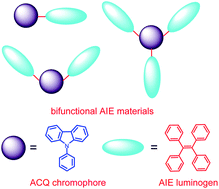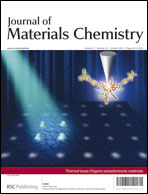Tetraphenylethene (TPE) is an archetypal luminogen that exhibits a phenomenon of aggregation-induced emission (AIE), while carbazole is a conventional chromophore which shows the opposite effect of aggregation-caused quenching (ACQ) of light emission in the condensed phase. Melding the two units at the molecular level generates a group of new luminescent materials that suffer no ACQ effect but depict high solid-state fluorescence quantum yields up to unity, demonstrative of the uniqueness of the approach to solve the ACQ problem of traditional luminophores. All the TPE–carbazole adducts are thermally and morphologically stable, showing high glass-transition temperatures (up to 179 °C) and thermal-degradation temperatures (up to 554 °C). Multilayer electroluminescence devices with configurations of ITO/NPB/emitter/TPBi/Alq3/LiF/Al are constructed, which exhibit sky blue light in high luminance (up to 13 650 cd m−2) and high current and external quantum efficiencies (up to 3.8 cd A−1, and 1.8%, respectively). The devices of the luminogens fabricated in the absence of NPB or hole-transporting layer show even higher efficiencies up to 6.3 cd A−1 and 2.3%, thanks to the good hole-transporting property of the carbazole unit.

You have access to this article
 Please wait while we load your content...
Something went wrong. Try again?
Please wait while we load your content...
Something went wrong. Try again?


 Please wait while we load your content...
Please wait while we load your content...